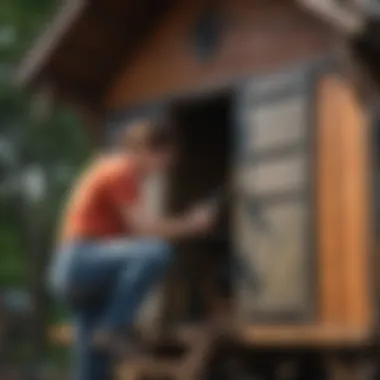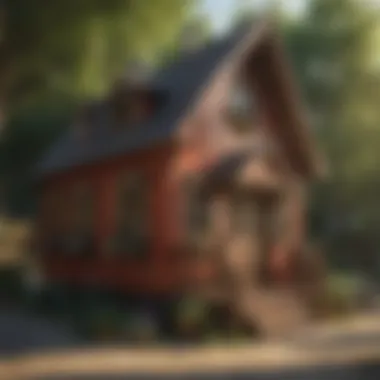Mastering the Art of Outdoor Playhouse Painting: A Comprehensive Guide


Playhouse Overview
When considering the painting of an outdoor playhouse, it is essential to first understand the diverse types of playhouses available in the market. Playhouses come in various designs, sizes, and materials, catering to different preferences and needs. From quaint wooden cottages to modern plastic structures, the options are vast and offer something for every family's unique taste and space requirements.
Features and Benefits
Before diving into the painting process, it's crucial to recognize the inherent features and benefits that playhouses bring to children's playtime. These structures not only provide a safe and designated play area but also stimulate creativity and imagination in young minds. Furthermore, their durability ensures that they withstand the wear and tear of lively play sessions, making them a long-lasting investment for families.
- Durability: Playhouses are typically built with sturdy materials that can withstand various weather conditions and rough play.
- Safety: Safety standards are a priority in playhouse design, ensuring that children can play freely without unnecessary risks.
- Imagination Stimulation: Playhouses offer a canvas for imaginative play, allowing children to create their own worlds and stories within the confines of their play space.
Buying Guide
In the process of selecting a playhouse for your children, several essential factors demand consideration to ensure that the chosen structure aligns with your requirements. Stakeholders are advised to assess aspects such as material, size, theme, and interactive elements prior to making a purchase decision.
- Material: The material of the playhouse determines its longevity and resistance to elements. Common options include wood, plastic, or fabric, each with its own set of advantages and maintenance needs.
- Size: The size of the playhouse should complement your available outdoor space while still providing a comfortable and enjoyable play area for children.
- Theme: Choose a playhouse theme that resonates with your child's interests, whether it be a fairy-tale castle, a pirate ship, or a mini farmhouse.
- Interactive Elements: Consider additional features such as slides, swings, or climbing walls to enrich the playhouse experience for children.
Maintenance Tips
Once the outdoor playhouse is in place, proper maintenance is key to prolonging its lifespan and keeping it in optimal condition for play. Basic upkeep tasks like regular cleaning and appropriate storage can significantly extend the playhouse's durability and aesthetic appeal.
- Cleaning Instructions: Depending on the material of the playhouse, certain cleaning techniques may be recommended to remove dirt, mold, or other accumulated debris.
- Storage Recommendations: During adverse weather conditions or when the playhouse is not in use, storing it properly can prevent damage and maintain its structural integrity for longer.
Customization Options
Personalizing the playhouse allows for a unique and tailored play area that reflects the interests and preferences of the children and the family. Various customization options are available, ranging from DIY kits to unique accessories that enhance the play space.
- Paint Your Own Playhouse Kits: Artistic Expression for Kids Children can unleash their creativity by painting their playhouse with vibrant colors and designs, making it truly their own.
- DIY Playhouse Kits: Family Bonding Through Building Engage in a meaningful family activity by assembling a DIY playhouse kit together, fostering teamwork and creativity.
- Build Your Own Playhouse: Tailored Designs for Personalized Play For a truly bespoke playhouse, consider constructing one from scratch, allowing for complete customization of the design and features.
- Unique Playhouse Accessories to Enhance the Play Space Add-ons such as curtains, flower boxes, or mini furniture can elevate the playhouse aesthetics and functionality, creating a charming play environment for children.
Introduction
In the realm of outdoor playhouses, a fresh coat of paint can work wonders beyond just visual appeal. The task of painting an outdoor playhouse is more than a simple cosmetic enhancement; it is a strategic maneuver aimed to fortify the structure against the harsh influences of the elements while elevating its overall aesthetics. Understanding the nuances of painting an outdoor playhouse is crucial for not only enhancing its charm but also ensuring its longevity in the face of environmental stresses. This article serves as a comprehensive guide, delving into every essential aspect to equip you with the knowledge and skills needed to undertake this project confidently.
Understanding the Importance of Painting an Outdoor Playhouse
Enhancing Aesthetics
The aspect of enhancing aesthetics goes beyond mere visual appeal; it is about infusing life and personality into the playhouse. By choosing the right color palette and finish, you can transform a bland structure into a vibrant focal point of your outdoor space. Enhancing aesthetics through paint allows for customization and personalization, turning a generic playhouse into a space that reflects your style and preferences. Additionally, a well-painted playhouse can complement the overall theme of your yard or garden, creating a cohesive and visually pleasing environment.
Protecting Against Elements
One of the primary reasons for painting an outdoor playhouse is to shield it from the damaging effects of the elements. Rain, snow, UV rays, and fluctuating temperatures can take a toll on the playhouse, leading to deterioration and structural issues over time. By applying a protective layer of paint, you create a barrier that repels moisture, prevents rot, and minimizes the impact of sunlight exposure. This protective shield not only extends the lifespan of the playhouse but also reduces the need for frequent repairs and maintenance, making it a cost-effective investment in the long run.
Increasing Durability


Painting an outdoor playhouse is a proactive measure to enhance its durability and resilience. The paint acts as a sealant that fortifies the surface against wear and tear, preventing premature deterioration and ensuring structural integrity. With the right paint choice and application techniques, you can significantly increase the playhouse's ability to withstand the rigors of outdoor conditions, including heavy usage by children and exposure to harsh weather elements. Ultimately, by enhancing the durability of the playhouse through paint, you are not only safeguarding your investment but also enhancing its functionality and longevity.
Overview of Painting Process
Preparation
The initial stage of the painting process, preparation, is crucial for laying a solid foundation for the subsequent steps. It involves thorough cleaning and sanding of the playhouse surface to remove dirt, debris, and imperfections that could affect the paint adhesion. Additionally, repairing damages such as cracks and holes ensures a smooth and seamless paint application, preventing future issues and promoting a professional finish.
Choosing the Right Paint
Selecting the appropriate type of paint is a critical decision that influences the outcome of the painting project. Outdoor playhouses require specific exterior paints that are formulated to withstand outdoor conditions, including moisture, UV exposure, and temperature variations. Understanding the differences between water-based and oil-based paints can help you make an informed choice based on your project requirements and long-term durability goals.
Application Techniques
The manner in which paint is applied plays a significant role in the final result and longevity of the finish. Brush, roller, and sprayer are common application methods, each with its pros and cons in terms of efficiency and coverage. Mastering the application techniques, including applying multiple coats for even coverage and allowing adequate drying time between layers, is essential for achieving a professional-looking and durable paint finish.
Finishing Touches
The finishing touches of the painting process add finesse and completeness to the project, elevating the aesthetic appeal and protection of the playhouse. Sealing the paint with a clear sealant enhances durability and provides an extra layer of defense against UV rays and weathering. Moreover, adding decorative elements such as stencils and trim details personalizes the playhouse and gives it a unique charm that sets it apart. These final touches not only enhance the visual impact but also contribute to the playhouse's longevity and resilience.
Preparation Stage
When embarking on the journey of painting an outdoor playhouse, the Preparation Stage serves as the foundation for a successful and lasting finish. This crucial step encompasses various key elements that are essential to ensure the longevity and quality of the paint job. One of the main benefits of focusing on the Preparation Stage is that it sets the stage for a smooth and professional-looking final result. By meticulously preparing the surface before applying the paint, you can address any imperfections, create a clean canvas for the paint to adhere to, and enhance the overall durability of the finish.
Cleaning and Sanding the Surface
Removing Dirt and Debris
In the realm of outdoor playhouse painting, the process of Removing Dirt and Debris holds significant importance. By meticulously eliminating any dirt, dust, or debris from the surface of the playhouse, you pave the way for a flawless paint application. This step is crucial as it ensures that the paint adheres properly to the surface, preventing any issues such as peeling or uneven coverage. Additionally, Removing Dirt and Debris contributes to the overall longevity of the paint job by creating a clean and smooth surface for the paint to bond with, ultimately enhancing the durability of the finish.
Sanding for Smooth Finish
Sanding for Smooth Finish plays a vital role in achieving a professional-looking paint job for your outdoor playhouse. This process involves smoothing out any rough or uneven areas on the surface, ensuring a seamless application of paint. By sanding the surface, you not only create a uniform canvas for painting but also help the paint adhere better, resulting in a long-lasting and aesthetically pleasing finish. The unique feature of Sanding for Smooth Finish lies in its ability to eliminate imperfections and promote a flawless final look, making it an indispensable step in the overall painting process.
Repairing Damages
Within the Preparation Stage, Repairing Damages is an essential aspect that demands attention to detail and precision. Filling Cracks and Holes is a key task in this phase, as it involves addressing any structural imperfections in the playhouse. By filling cracks and holes with suitable fillers, you can prevent moisture penetration, enhance the structural integrity of the playhouse, and create a seamless base for the paint to adhere to, thus prolonging the lifespan of the paint job. Another critical aspect of Repairing Damages is Replacing Rotten Wood, which involves substituting deteriorated wood with new, sturdy material. This action not only ensures the structural stability of the playhouse but also guards against future damage and decay, optimizing the overall longevity and quality of the painting job.
Filling Cracks and Holes
Filling Cracks and Holes is a meticulous process that requires precision and attention to detail when preparing an outdoor playhouse for painting. The key characteristic of this task lies in its ability to address structural weaknesses and imperfections in the playhouse, ultimately aiding in the creation of a seamless and durable paint surface. By meticulously filling cracks and holes with appropriate fillers, you can prevent moisture damage, preserve the structural integrity of the playhouse, and achieve a uniform paint application. The unique feature of Filling Cracks and Holes is its capability to fortify the playhouse against environmental elements, ensuring a long-lasting and high-quality paint finish.
Replacing Rotten Wood
Replacing Rotten Wood is a critical step in the Repairing Damages phase of painting an outdoor playhouse. This task involves removing decayed or damaged wood from the structure and replacing it with new, sound material. The key characteristic of Replacing Rotten Wood lies in its ability to strengthen the playhouse's framework, mitigate the risk of further decay, and provide a solid foundation for the paint application. By addressing rotten wood promptly, you can safeguard the structural integrity of the playhouse, prevent paint issues, and extend the lifespan of the paint job. The advantages of Replacing Rotten Wood include enhancing the overall durability and longevity of the outdoor playhouse, ensuring a resilient and enduring finish.


Masking and Taping
Masking and Taping play a crucial role in the Preparation Stage of painting an outdoor playhouse, offering essential protection and precision for the painting process. Protecting Windows and Fixtures involves carefully covering delicate areas such as windows, hardware, and fixtures to shield them from paint splatters and overspray. This step ensures that these elements remain clean and untouched during the painting process, preserving their aesthetic appeal and functionality. Ensuring Clean Edges is another important task that involves taping off edges and boundaries to create crisp and defined lines in the paint job. This meticulous approach guarantees a professional finish, prevents paint bleed, and contributes to the overall visual appeal of the playhouse.
Protecting Windows and Fixtures
Protecting Windows and Fixtures is a critical aspect of the painting process that entails safeguarding vulnerable areas from paint damage. The key characteristic of this task is its ability to preserve the integrity and functionality of windows, hardware, and fixtures by preventing them from being coated with paint. By carefully masking and protecting these elements, you ensure that they remain pristine and operational after the paint job is complete. The unique feature of Protecting Windows and Fixtures lies in its attention to detail, which enhances the overall aesthetics and functionality of the outdoor playhouse while maintaining the durability of the paint finish.
Ensuring Clean Edges
Ensuring Clean Edges is an essential step in achieving a polished and professional-looking paint job for your outdoor playhouse. This process involves using tape to delineate clean lines and boundaries, preventing paint bleed and creating sharp edges in the final finish. The key characteristic of Ensuring Clean Edges is its ability to provide a clean and precise look to the painted surface, enhancing the overall visual appeal of the playhouse. By meticulously masking and taping the edges, you can achieve a flawless result that exudes craftsmanship and attention to detail, elevating the aesthetic quality of the painting project.
Paint Selection
When it comes to painting an outdoor playhouse, the paint selection stage plays a crucial role in determining the overall outcome of the project. Choosing the right type of paint and selecting appropriate colors and finishes not only enhances the aesthetics of the playhouse but also ensures its longevity by providing protection against the elements. This section will delve into the significance of paint selection in this comprehensive guide, focusing on specific elements that need to be considered to achieve a professional and durable finish.
Choosing the Right Type of Paint
Exterior Paint vs. Indoor Paint
In the realm of painting outdoor playhouses, the choice between exterior paint and indoor paint holds paramount importance. Exterior paint is specifically formulated to withstand outdoor conditions, including exposure to sunlight, rain, and temperature fluctuations. Its key characteristic lies in its durability and resistance to fading, making it a popular and beneficial choice for outdoor structures like playhouses. The unique feature of exterior paint is its ability to provide long-lasting protection against various weather elements, ensuring that the playhouse maintains its vibrant appearance for years to come.
On the other hand, indoor paint is designed for interior spaces, lacking the robust formula required to withstand outdoor challenges. While indoor paint may offer a wide range of colors and finishes, it lacks the protective properties necessary for outdoor applications. Therefore, when painting an outdoor playhouse, opting for exterior paint is the preferred choice to ensure optimal durability and longevity.
Water-Based vs. Oil-Based Paint
The decision between water-based and oil-based paint is another crucial consideration in outdoor playhouse painting. Water-based paint, also known as latex paint, is favored for its quick drying time, low odor, and easy cleanup with soap and water. It is a popular choice for DIY enthusiasts due to its user-friendly nature. However, water-based paint may not offer the same level of durability as oil-based paint.
Oil-based paint, on the other hand, is renowned for its durability and excellent adhesion to various surfaces. It provides a robust protective layer, making it ideal for outdoor applications where resilience against environmental stressors is essential. While oil-based paint requires mineral spirits for cleanup and has a longer drying time, its advantages in terms of durability and longevity make it a preferred option for painting outdoor playhouses.
In summary, the choice between exterior paint vs. indoor paint and water-based vs. oil-based paint significantly impacts the overall quality and performance of the paint finish on an outdoor playhouse. By understanding the unique characteristics and advantages of each type of paint, you can make informed decisions that will contribute to a professional-looking and long-lasting result.
Paint Application Techniques
In the realm of outdoor playhouse painting, mastering paint application techniques is crucial for achieving a durable and professional-looking finish. The application process not only enhances the aesthetic appeal of the playhouse but also plays a significant role in protecting it against various elements, ensuring longevity and durability.
Brush vs. Roller vs. Sprayer
Pros and Cons of Each Method
When considering paint application techniques, it is essential to weigh the pros and cons of using a brush, roller, or sprayer. Each method has its own unique characteristics that contribute to the overall outcome of the painting process.
Brushes offer precision and control, allowing for detailed work in tricky areas such as trims and corners. However, they may leave visible brush marks and require more time and effort compared to other methods. Rollers, on the other hand, provide quick and even coverage over larger surfaces but might not reach tight spots as effectively.


Sprayers excel in covering large areas rapidly and delivering a smooth finish but require proper skills to avoid overspray and ensure even application. Understanding the specific advantages and disadvantages of each method is essential for selecting the most suitable approach based on the project requirements and personal preferences.
Best Practices for Efficiency
To optimize the paint application process, there are certain best practices that can enhance efficiency and overall results. Proper preparation of the surface, including cleaning and priming, ensures better adhesion and longevity of the paint. Additionally, selecting the right tools and materials for each method is crucial in achieving a seamless and high-quality finish.
Furthermore, maintaining a consistent painting technique, such as starting from the top and working downwards, helps prevent drips and uneven coats. Proper ventilation during painting not only speeds up the drying process but also promotes a healthier environment. By adhering to these best practices, DIY enthusiasts can streamline their painting efforts and achieve professional-looking results with ease.
Finishing Touches
The final stage of painting an outdoor playhouse, the finishing touches, holds paramount importance in this article. These crucial elements elevate the overall look of the playhouse and ensure its longevity against environmental factors. Incorporating finishing touches not only adds aesthetic appeal but also enhances the durability of the paint, safeguarding the playhouse for extended periods. Attention to detail during this phase sets apart a professionally painted playhouse from a hastily done job.
Sealing and Protecting the Paint
Applying Clear Sealant
When it comes to sealing and protecting the paint on an outdoor playhouse, applying clear sealant emerges as a critical step towards achieving lasting results. Clear sealant acts as an invisible shield, providing an additional layer of protection against moisture, dust, and other harmful elements. Its transparency ensures that the paint color and texture stay intact while preserving the paint's vibrancy over time. The key characteristic of clear sealant lies in its ability to create a barrier that seals the paint, preventing it from chipping or peeling. This beneficial choice enhances the durability of the paint job and is a popular option for outdoor playhouses due to its weather-resistant properties. While clear sealant offers remarkable protection, it is important to note that it requires reapplication periodically to maintain its effectiveness.
Protecting Against UV Rays
Shielding the paint on an outdoor playhouse from UV rays is essential for prolonging its lifespan and maintaining its visual appeal. Protecting against UV rays involves incorporating additives or choosing UV-resistant coatings that prevent the paint from fading or deteriorating when exposed to sunlight. This key characteristic safeguards the playhouse's vibrant colors and prevents discoloration caused by UV exposure, ensuring a long-lasting finish. Opting for UV protection in outdoor paints is a wise choice, particularly for playhouses that are constantly exposed to sunlight. While protecting against UV rays offers undeniable advantages in preserving the paint's aesthetics, it is essential to acknowledge that prolonged exposure to harsh sunlight may still necessitate periodic maintenance to uphold the paint's integrity.
Adding Decorative Elements
Enhancing the visual appeal of an outdoor playhouse involves adding decorative elements that not only personalize the space but also elevate its overall charm. Incorporating decorative elements such as stencils and trim details allows for a unique touch that reflects the playhouse owner's personality or preferences. Personalizing with stencils offers a creative way to customize the playhouse's appearance, ranging from whimsical designs to customized patterns that add a distinct flair. The key characteristic of personalizing with stencils lies in its ability to transform a plain surface into a personalized masterpiece, making the playhouse stand out in a playful and imaginative manner. While personalizing with stencils enhances the visual appeal of the playhouse, it is crucial to consider factors such as stencil placement and color coordination to achieve a cohesive look.
Enhancing with trim details provides another dimension of customization by embellishing architectural features or outlining specific areas of the playhouse. The key characteristic of enhancing with trim details lies in its capacity to add sophistication and definition to the playhouse's structure, creating a polished and refined aesthetic. Choosing the right trim details can accentuate the playhouse's design, whether it be through intricate moldings, decorative panels, or architectural embellishments. While enhancing with trim details elevates the playhouse's overall appearance, it is important to ensure that the selected details complement the existing design elements cohesively, enhancing the playhouse's visual impact.
Maintenance Tips
Maintaining an outdoor playhouse is crucial for ensuring its longevity and keeping it looking fresh and vibrant. Regular upkeep not only enhances the aesthetics but also prevents costly repairs down the line. By following some simple maintenance tips, you can preserve the beauty and structural integrity of your outdoor play space for years to come.
Regular Cleaning and Inspection
Preventing Mold and Mildew
Preventing mold and mildew growth on your outdoor playhouse is essential to safeguarding its structural integrity and the health of those who use it. The damp outdoor environment can create the perfect breeding ground for these harmful organisms. Regularly inspecting and cleaning the playhouse can help identify and tackle early signs of mold and mildew. Utilizing mold-resistant paint or sealant can provide an added layer of protection against these issues.
Checking for Wear and Tear
Checking for wear and tear involves a thorough inspection of the playhouse's components to identify any damage or deterioration. From loose fixtures to peeling paint, small issues can escalate if left unaddressed. By routinely examining the playhouse for signs of wear, you can intervene promptly and carry out the necessary repairs. This proactive approach not only maintains the playhouse's appearance but also ensures that it remains safe for children to enjoy.
Touching Up Paint as Needed
Maintaining Fresh Appearance
Touching up the paint on your outdoor playhouse as needed is essential for preserving its fresh appearance and protecting the underlying material from the elements. Harsh weather conditions and regular use can cause the paint to fade or chip over time. By addressing these issues promptly, you can prevent extensive damage and maintain the playhouse's visual appeal. Opting for high-quality exterior paint that is specifically formulated for outdoor surfaces can enhance the longevity of your touch-ups.
Addressing Chips and Scratches
Addressing chips and scratches promptly is key to preventing further damage and maintaining the playhouse's overall integrity. Whether caused by rough play or environmental factors, these blemishes can compromise the protective barrier provided by the paint. By patching up these imperfections with matching paint, you can prevent moisture infiltration and safeguard the playhouse against decay. Regularly inspecting for chips and scratches allows you to tackle them early on, contributing to the playhouse's durability and aesthetics.



